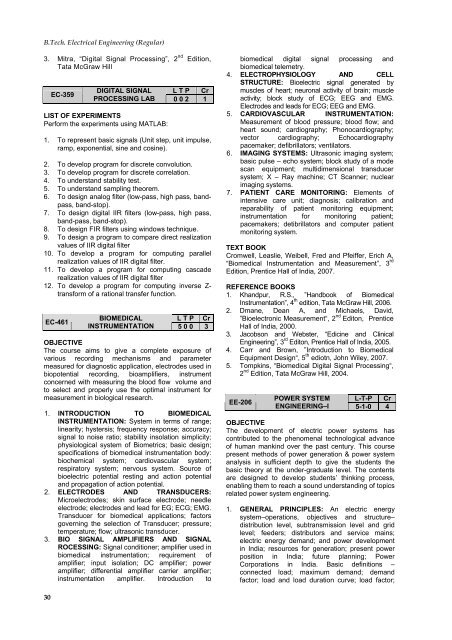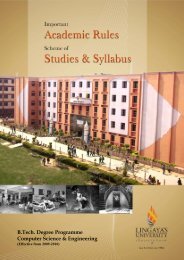B.<strong>Tech</strong>. <strong>Electrical</strong> <strong>Engineering</strong> (Regular)3. Mitra, “Digital Signal Processing”, 2 nd Edition,Tata McGraw HillEC-359DIGITAL SIGNAL L T P CrPROCESSING LAB 0 0 2 1LIST OF EXPERIMENTSPerform the experiments using MATLAB:1. To represent basic signals (Unit step, unit impulse,ramp, exponential, sine and cosine).2. To develop program for discrete convolution.3. To develop program for discrete correlation.4. To understand stability test.5. To understand sampling theorem.6. To design analog filter (low-pass, high pass, bandpass,band-stop).7. To design digital IIR filters (low-pass, high pass,band-pass, band-stop).8. To design FIR filters using windows technique.9. To design a program to compare direct realizationvalues of IIR digital filter10. To develop a program for computing parallelrealization values of IIR digital filter.11. To develop a program for computing cascaderealization values of IIR digital filter12. To develop a program for computing inverse Z-transform of a rational transfer function.EC-461BIOMEDICALL T P CrINSTRUMENTATION 5 0 0 3OBJECTIVEThe course aims to give a complete exposure ofvarious recording mechanisms and parametermeasured for diagnostic application, electrodes used inbiopotential recording, bioamplifiers, instrumentconcerned with measuring the blood flow volume andto select and properly use the optimal instrument formeasurement in biological research.1. INTRODUCTION TO BIOMEDICALINSTRUMENTATION: System in terms of range;linearity; hystersis; frequency response; accuracy;signal to noise ratio; stability insolation simplicity;physiological system of Biometrics; basic design;specifications of biomedical instrumentation body:biochemical system; cardiovascular system;respiratory system; nervous system. Source ofbioelectric potential resting and action potentialand propagation of action potential.2. ELECTRODES AND TRANSDUCERS:Microelectrodes; skin surface electrode; needleelectrode; electrodes and lead for EG; ECG; EMG.Transducer for biomedical applications; factorsgoverning the selection of Transducer; pressure;temperature; flow; ultrasonic transducer.3. BIO SIGNAL AMPLIFIERS AND SIGNALROCESSING: Signal conditioner; amplifier used inbiomedical instrumentation; requirement ofamplifier; input isolation; DC amplifier; poweramplifier; differential amplifier carrier amplifier;instrumentation amplifier. Introduction tobiomedical digital signal processing andbiomedical telemetry.4. ELECTROPHYSIOLOGY AND CELLSTRUCTURE: Bioelectric signal generated bymuscles of heart; neuronal activity of brain; muscleactivity; block study of ECG; EEG and EMG.Electrodes and leads for ECG; EEG and EMG.5. CARDIOVASCULAR INSTRUMENTATION:Measurement of blood pressure; blood flow; andheart sound; cardiography; Phonocardiography;vector cardiography; Echocardiographypacemaker; defibrillators; ventilators.6. IMAGING SYSTEMS: Ultrasonic imaging system;basic pulse – echo system; block study of a modescan equipment; multidimensional transducersystem; X – Ray machine; CT Scanner; nuclearimaging systems.7. PATIENT CARE MONITORING: Elements ofintensive care unit; diagnosis; calibration andreparability of patient monitoring equipment;instrumentation for monitoring patient;pacemakers; detibrillators and computer patientmonitoring system.TEXT BOOKCromwell, Leaslie, Weibell, Fred and Pfeiffer, Erich A,“Biomedical Instrumentation and Measurement”, 3 rdEdition, Prentice Hall of India, 2007.REFERENCE BOOKS1. Khandpur, R.S., ”Handbook of BiomedicalInstrumentation”, 4 th edition, Tata McGraw Hill, 2006.2. Dmane, Dean A, and Michaels, David,”Bioelectronic Measurement“, 2 nd Editon, PrenticeHall of India, 2000.3. Jacobson and Webster, “Edicine and Clinical<strong>Engineering</strong>”, 3 rd Editon, Prentice Hall of India, 2005.4. Carr and Brown, ”Introduction to BiomedicalEquipment Design“, 5 th ediotn, John Wiley, 2007.5. Tompkins, “Biomedical Digital Signal Processing“,2 nd Edition, Tata McGraw Hill, 2004.EE-206POWER SYSTEM L-T-P CrENGINEERING–I 5-1-0 4OBJECTIVEThe development of electric power systems hascontributed to the phenomenal technological advanceof human mankind over the past century. This coursepresent methods of power generation & power systemanalysis in sufficient depth to give the students thebasic theory at the under-graduate level. The contentsare designed to develop students’ thinking process,enabling them to reach a sound understanding of topicsrelated power system engineering.1. GENERAL PRINCIPLES: An electric energysystem–operations, objectives and structure–distribution level, subtransmission level and gridlevel; feeders; distributors and service mains;electric energy demand; and power developmentin India; resources for generation; present powerposition in India; future planning; PowerCorporations in India. Basic definitions –connected load; maximum demand; demandfactor; load and load duration curve; load factor;30
Lingaya’s University, Faridabadbase load and peak load power plants; plantcapacity factor; plant use factor.2. THERMAL POWER, HYDRO POWER, NUCLEARPOWER STATIONS: Selection of site for thermalpower plants; thermodynamic cycle for steam flow;Rankine cycle; actual Rankine cycle; reheat cycle;regenerative cycle qualitative treatment; generallayout & main components of thermal powerstation (in brief). Available hydropower; selection ofsite for hydroelectric power stations; theirclassifications; layout and main components (inbrief). Nuclear power plants – fission energy;general layout and main components (in brief);waste disposal; types of nuclear reactors (in brief);general lay out and main components (in brief);waste disposal; types of nuclear radiations & theireffect.3. CIRCUIT PARAMETERS OF TRANSMISSIONLINES: Review of calculations of resistance,inductance, capacitance of a single conductor,multi conductor, single phase and three phasetransmission lines; transposition; double circuitlines; skin and proximity effect; current carryingcapacity and use of Tables.4. ANALYSIS OF TRANSMISSION LINES:Classification; generalized ABCD constants;representation & steady state analysis of short andmedium lines; regulation and efficiency; nominal–Tand pi circuits; Long line: current –voltagerelationship, hyperbolic solution; surge impedance;Surge impedance loading; lumped circuitequivalent representation; Ferranti effect; powerflow through a transmission line; reactive powergeneration / absorption of a line; power transfercapability; shunt and series compensation (inbrief).5. CORONA AND RADIO INTERFERANCE: Electricstress between parallel conductors; disruptive andvisual critical voltage; corona power loss; factorseffecting corona; effects of corona. Radiointerference-electromagnetic effect; electrostaticeffect; reduction of interference.6. INSULATORS: Overhead line insulators –typesand materials; voltage distribution calculations;different methods of equalizing voltage dropsacross insulators of string; string efficiency.7. INSULATED CABLES: Cable conductor,insulating, sheathing and armouring materials;single core and three core belted cables, gasand oil pressure cables (qualitative treatment);insulation resistance and capacitancecalculations; capacitive and intersheath grading;sheath and di-electric loss; thermal rating ofcables.TEXT BOOKSingh, S. N., “Electric Power Generation, Transmissionand Distribution”, 2 nd Edition, Prentice Hall of India, Pvt.Ltd.REFERENCE BOOKS1. Sivanagaraju, S. & Satyanarayana, S., “ElectricPower Transmission & Distribution”, ‘PearsonEducation.2. Glover, J. Duncan, Sarma, Mulukutla S., et.al,“Power System Analysis and Design”, ‘CengageLearning India Pvt. Ltd.EE-302POWER SYSTEM L-T-P CrENGINEERING –II 5-1-0 4OBJECTIVE<strong>Electrical</strong> power is an energy transportation system. Alarge variety of equipment is necessary to economicallyand efficiently distribute electrical power. Practical,reliable and safe distribution depends on protectivedevices to sense fault conditions and disconnectmalfunctioning equipment. The course is designed forexhaustive study of faults, circuit interrupters, protectiverelays and system protection.1. SYSTEM REPRESENTATION AND FAULTANALYSIS: Single line representation; per unitsystem; modeling of transformer, load &synchronous machine; nature and causes of faults;fault analysis – symmetrical faults on asynchronous machine at no load and full load;calculations for current limiting reactors – their use,construction and location.2. SYMMETRICAL COMPONENTS: Unbalancedfaults-symmetrical component transformation;phase shift in star-delta transformation;sequence impedances. Unsymmetrical faultsusing symmetrical components – sequencenetworks and their inter-connection for shunttypes of faults.3. CIRCUIT INTERRUPTERS:(a) Fuses: Types; ratings; the mechanism of fuseperformance – characteristics anddiscrimination; construction and characteristicsof HRC fuses.(b) Circuit Breakers: Theory of formation andextinction of arcs, arc control devices andarc quenching media; inductive andcapacitive current interruption; currentchopping; resistive switching; recovery andrestriking voltage and rate of rise ofrestriking voltage and factors affecting them;air blast circuit breakers; oil circuit breakers;SF 6 circuit breakers; rating of circuitbreakers; automatic switch.4. PROTECTIVE RELAYS: General introduction;classification of relays, basic requirements ofprotective relaying; methods of discrimination;universal torque equation; construction features ofelectromagnetics relays – attracted armature,induction (disc and cup) type.5. RELAY APPLICATION & CHARACTERISTICS:Over current, instantaneous over current, IDMT,directional and differential relays; distance relays -plain impedance, mho, reactance, offset mho,transmission line & feeder protection and carriercurrent protection.6. APPARATUS PROTECTION: Transformer,generator, Transformer generator unit protection &motor protection; Neutral grounding.7. STATIC & DIGITAL RELAYS: Basic principle ofstatic relaying, phase & amplitude comparators,introduction to digital relays-basic principle;applications of microprocessors and computerrecenttrends.TEXT BOOKChakrabarti, A., Soni, M.L., Gupta, P.V., “A Text Book onPower System <strong>Engineering</strong>”, Dhanpat Rai & Sons, 2010.31
- Page 1 and 2: B.Tech. Degree ProgrammeElectrical
- Page 5 and 6: Lingaya’s University, FaridabadAB
- Page 7 and 8: IMPORTANT ACADEMIC RULESB.Tech. Deg
- Page 9 and 10: Lingaya’s University, Faridabadac
- Page 11 and 12: Lingaya’s University, FaridabadSe
- Page 13 and 14: Lingaya’s University, FaridabadIn
- Page 15 and 16: CATEGORY-WISE LIST OF COURSESLingay
- Page 17 and 18: Lingaya’s University, FaridabadSU
- Page 19 and 20: Lingaya’s University, FaridabadSc
- Page 22 and 23: B.Tech. Electrical Engineering (Reg
- Page 24 and 25: B.Tech. Electrical Engineering (Reg
- Page 26 and 27: B.Tech. Electrical Engineering (Reg
- Page 28 and 29: B.Tech. Electrical Engineering (Reg
- Page 30 and 31: B.Tech. Electrical Engineering (Reg
- Page 32 and 33: B.Tech. Electrical Engineering (Reg
- Page 36 and 37: B.Tech. Electrical Engineering (Reg
- Page 38 and 39: B.Tech. Electrical Engineering (Reg
- Page 40 and 41: B.Tech. Electrical Engineering (Reg
- Page 42 and 43: B.Tech. Electrical Engineering (Reg
- Page 44 and 45: B.Tech. Electrical Engineering (Reg
- Page 46 and 47: B.Tech. Electrical Engineering (Reg
- Page 48 and 49: B.Tech. Electrical Engineering (Reg
- Page 50 and 51: B.Tech. Electrical Engineering (Reg
- Page 52 and 53: B.Tech. Electrical Engineering (Reg
- Page 54 and 55: B.Tech. Electrical Engineering (Reg
- Page 56 and 57: B.Tech. Electrical Engineering (Reg
- Page 58 and 59: B.Tech. Electrical Engineering (Reg
- Page 60 and 61: B.Tech. Electrical Engineering (Reg
- Page 62 and 63: B.Tech. Electrical Engineering (Reg
- Page 64 and 65: B.Tech. Electrical Engineering (Reg
- Page 66 and 67: B.Tech. Electrical Engineering (Reg
- Page 68 and 69: B.Tech. Electrical Engineering (Reg
- Page 71 and 72: OPEN ELECTIVELingaya’s University
- Page 73 and 74: Lingaya’s University, Faridabadch
- Page 75 and 76: Lingaya’s University, Faridabad4
- Page 77 and 78: Lingaya’s University, Faridabad6.
- Page 79 and 80: Lingaya’s University, FaridabadEL
- Page 81 and 82: Lingaya’s University, Faridabad5
- Page 83 and 84: Lingaya’s University, Faridabador
- Page 85 and 86:
Lingaya’s University, Faridabad4.
- Page 87:
Lingaya’s University, Faridabad83
















